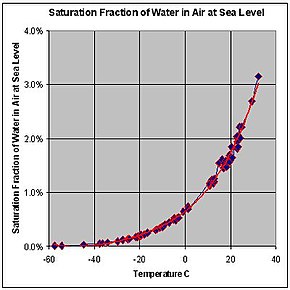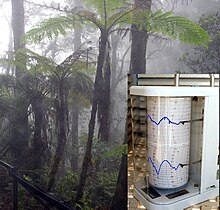
Back Doupunt Afrikaans درجة تكثف Arabic Puntu de rosada AST Пункт расы Byelorussian Точка на оросяване Bulgarian শিশিরাঙ্ক Bengali/Bangla Punt de rosada Catalan خاڵی شەونم CKB Rosný bod Czech Сывлăм пăнчи CV

| Humidity and hygrometry |
|---|
 |
| Specific concepts |
| General concepts |
| Measures and instruments |
The dew point of a given body of air is the temperature to which it must be cooled to become saturated with water vapor. This temperature depends on the pressure and water content of the air. When the air is cooled below the dew point, its moisture capacity is reduced and airborne water vapor will condense to form liquid water known as dew.[1] When this occurs through the air's contact with a colder surface, dew will form on that surface.[2]
The dew point is affected by the air's humidity. The more moisture the air contains, the higher its dew point.[3]
When the temperature is below the freezing point of water, the dew point is called the frost point, as frost is formed via deposition rather than condensation.[4] In liquids, the analog to the dew point is the cloud point.
- ^ "How To: Eliminate Window Condensation". 15 November 2021.
- ^ "Dew Point". Glossary – NOAA's National Weather Service. 25 June 2009.
- ^ John M. Wallace; Peter V. Hobbs (24 March 2006). Atmospheric Science: An Introductory Survey. Academic Press. pp. 83–. ISBN 978-0-08-049953-6.
- ^ "Frost Point". Glossary – NOAA's National Weather Service. 25 June 2009.